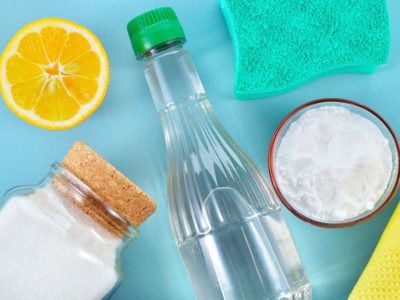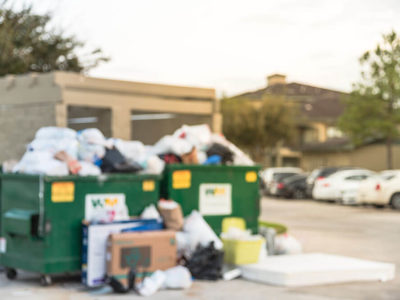Table of Contents[Hide][Show]
- The Problems of Packaging
- Some Positive Steps Forward
- Consumer Impacts
Here’s What You Can Do Today+−
- Recycle
- Avoid Single-Use & Disposable Options
- 7 Reasons To Ditch Plastic Utensils For Good
- Buy In Bulk
- Bring Your Own Packaging
- Rent or Borrow
- Take Care of What You’ve Got
- Eat More Plants
- 10 Natural Cleaning Ingredients – Goodbye Toxic Products!
- 4 Indoor Plants that Purify the Air in Your Home
- 4 Simple Ways to Reduce Plastics In Your Home
You’re supporting conscious companies by purchasing organic produce, getting your coffee from the local shop, and doing your online shopping with free-trade certified resellers. All important and noble pursuits. But, what is the cumulative effect of the packaging involved in your purchasing choices? Perhaps the next step in spending with social responsibility is to consider how to reduce the waste.
Today we’ll examine the failures and successes of modern packaging and what you can do as a consumer to reduce packaging waste.
The Problems of Packaging
Packaging materials make up more than 30 percent of landfill waste in the US, around 75 million tons every year. In addition to generating tons of waste, packaging supplies lead to:
- Demand on natural resources
- Gas emissions and energy use, adding to the negative human impact on climate change
- Harm to wildlife before and after the materials have been discarded
- Air, water, and soil pollution from manufacture and transportation practices
- Higher financial cost to business owners and consumers
Some Positive Steps Forward
The story of packaging isn’t all doom and gloom. In fact, packaging in the US has gotten slimmer and lighter over the years. As plastics and films get stronger, less of it is needed, reducing some of the environmental burden. For example, plastic bottles have gotten thinner and easier to crush, making for a smoother recycling process. Replacing heavy plastic with films means more can be transported in one vehicle, reducing fossil fuel use and emissions.
If you’re a business owner, here are some quick tips to consider:
- Rethink your packaging for creative ways to keep your product secure while using fewer materials and those that can be recycled.
- Take a cradle-to-grave approach when considering your packaging materials. In other words, what’s the impact from manufacturing to waste? Was it sustainably produced? How far did it travel to get to you? What is likely to happen with it at the consumer end?
- If you go through a lot of cardboard, an industrial shredder will turn it into practical and eco-friendly packaging fill.
- Get your staff on board by encouraging creativity around packaging and making sure they’re well trained on waste disposal/reduction practices.
Consumer Impacts
Consumers are forcing manufacturers to get creative as the demand for eco-friendlier options increase. The rise of social media has given opportunity for consumers to let their voices be heard by using direct communication to company representatives on a massive scale. This has lead to large companies like Dell swapping out their packaging for recyclables, and using less of it. Other companies are focusing on reduced emissions and resource use in the manufacture of their packaging, or even using renewable energy to run the plant making the materials.
Here’s What You Can Do Today
While there is exciting progress happening in packaging reduction, there is certainly more work to be done, and much of that work starts with the individual. Here are some practical tips for reducing the packaging that your household contributes to the waste stream.
Recycle
You already know this one, right? But, are you doing all you can? Are you recycling the items that are less convenient? Are you encouraging co-workers and family members to recycle?
Look for recycled and recyclable packaging. Whenever possible, support those companies using recycled products. And consider what will be done with the packaging when you’re done with the item. For example, a glass peanut butter jar can be reused and generally requires fewer resources to manufacture and recycle than a plastic one. Additionally, materials like glass can be recycled many times into many things before its life is over. The lifecycle of plastic is short, even when it’s recyclable. The material becomes weak and there just isn’t much that plastic can be recycled into.
Avoid Single-Use & Disposable Options
Brewing an individual cup of coffee might be handy, but the plastic k-cups really pile up. Instead, consider purchasing reusable k-cups or opt for a more traditional coffee pot or French press.
Avoid individual snack packages, opting instead for a larger package that can be portioned out into reusable containers. This goes for individual drink containers, too. Buy a large bottle and refill your glass. Or, carry a glass or stainless steel water bottle instead of buying a plastic one.
Related
7 Reasons To Ditch Plastic Utensils For Good
Plastic utensils contain chemicals that are harmful to the environment and your health, are slow to break down, and are even expensive long-term. Learn why It’s time to ditch them for good and some of the other options you have.
Buy In Bulk
For items with a long shelf life, opt for the larger container. For dry goods, purchase from bulk bins when possible. Yes, they require plastic bags, but they take up less room in the landfill than what you find on the shelf. And they can often be reused or recycled.
Bring Your Own Packaging
This is one area where you can reuse the packaging from the bullet above. Some stores also have the option to bring your own containers for things like syrups and spreads, or even shampoo and body wash. And of course, bring your own grocery bags as well. You can also use this practice when going to the coffee shop or even out to eat. Bring your own container for leftovers!
Rent or Borrow
All sorts of things from formal wear to kitchen appliances can be borrowed from a friend or rented from a local business—sometimes at no cost! For example, some non-profits and local jurisdictions provide community tool libraries, and some school districts offer donated prom dresses.
Take Care of What You’ve Got
Really evaluate whether things like appliances or furniture needs replacement, or if it just needs repair or better maintenance. (This can also save you a ton of money!)
Eat More Plants
Fruits and veggies are not only the healthiest options, but most don’t require any packaging. Bonus points if you grow them yourself! Also, cooking from scratch will generally mean less packaging than purchasing processed and frozen foods.
Final Thoughts
In less than 20 years, US consumers have reduced the percentage of packaging in landfills by 39 percent. This is great progress, but there’s more work to do, and we can make a difference with our individual actions.





